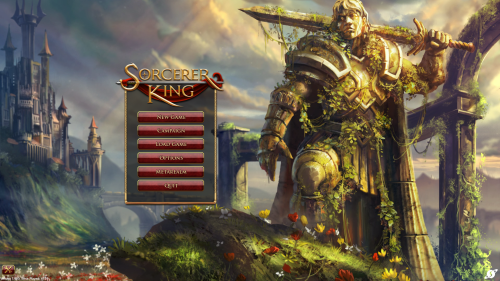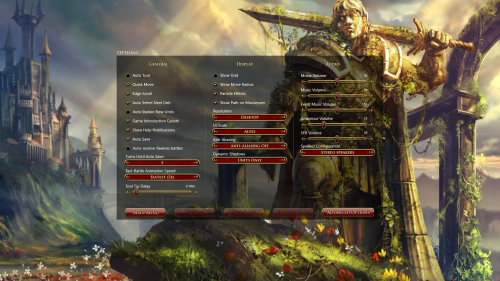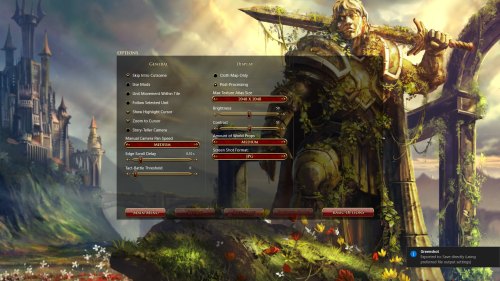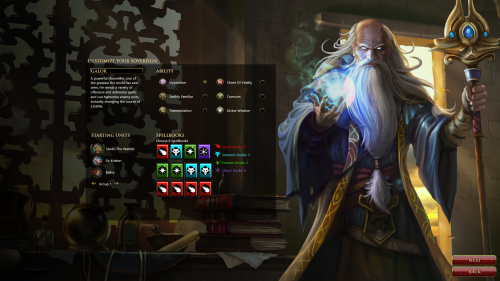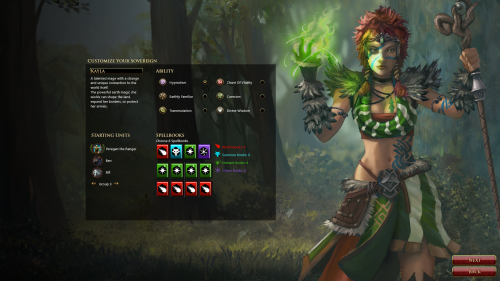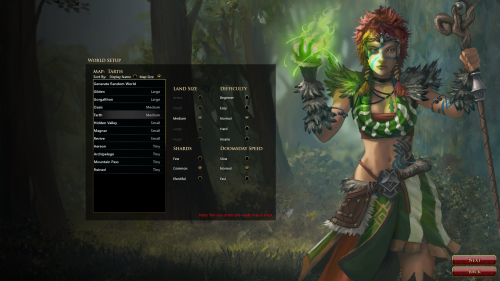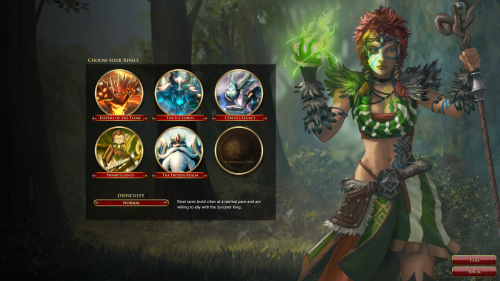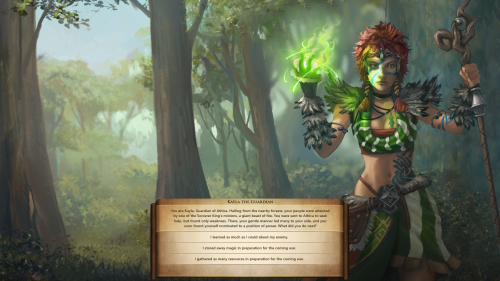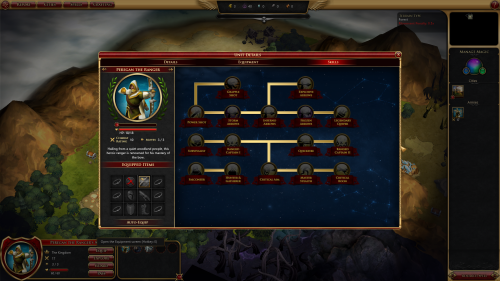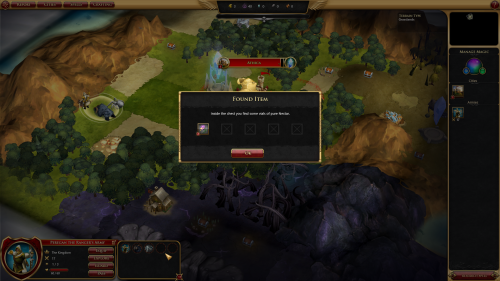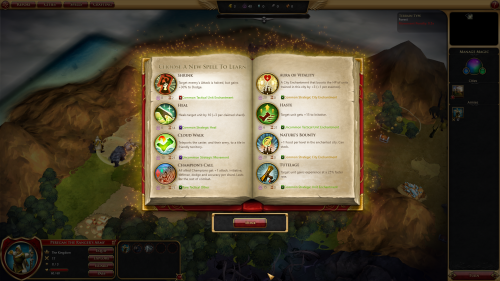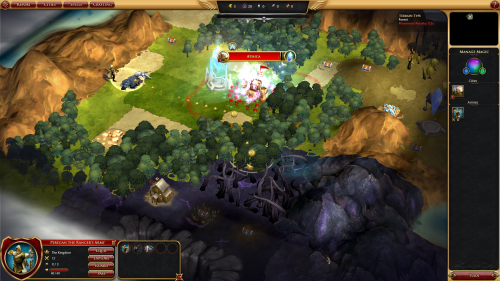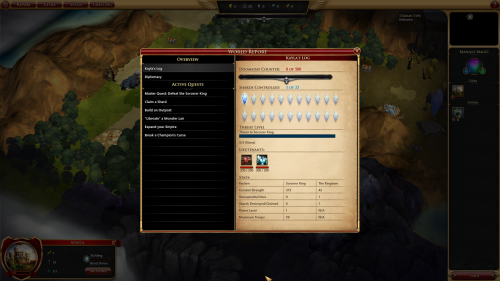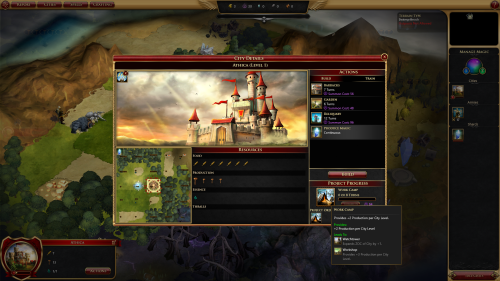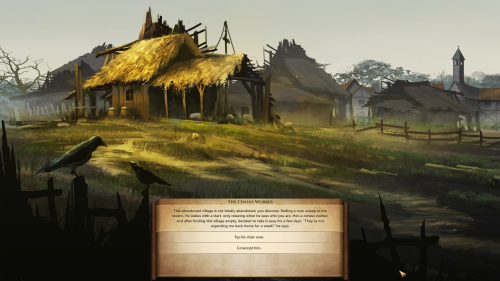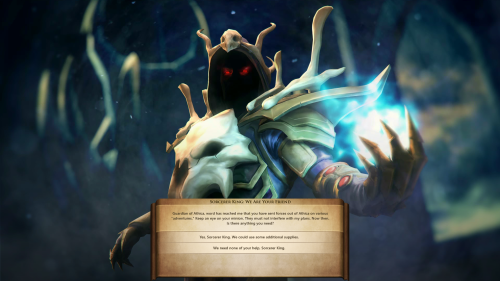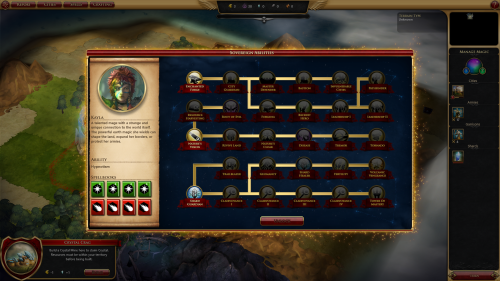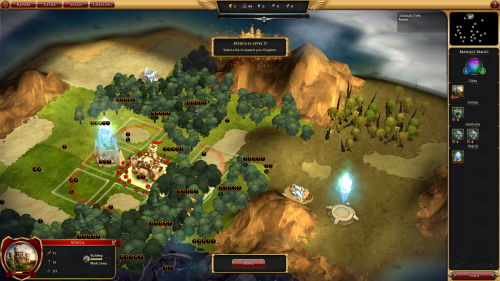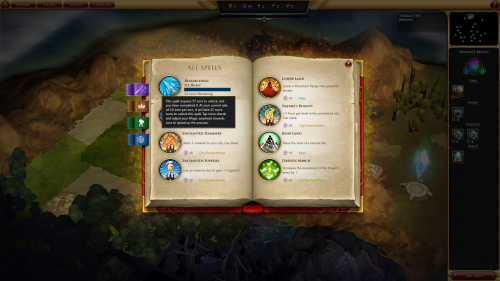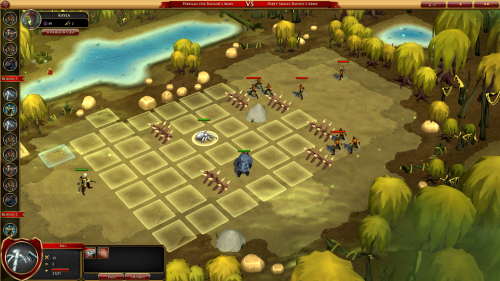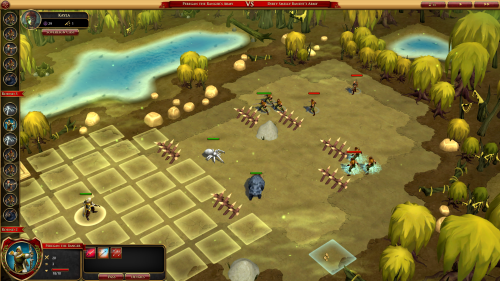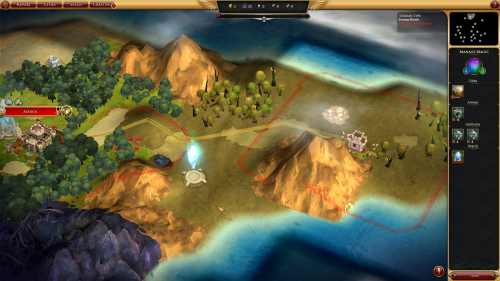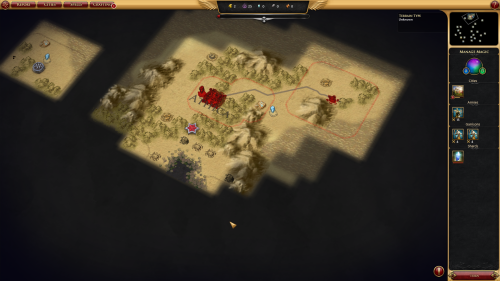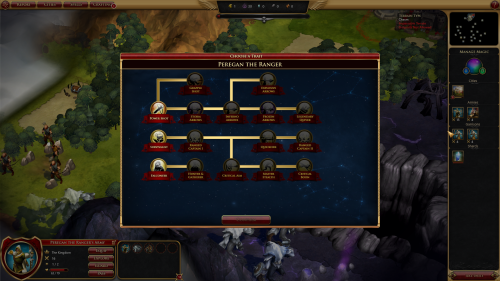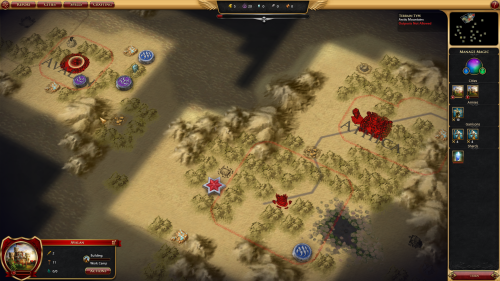From Blogging Games
It’s been a while since I wrote anything here and honestly, this was mostly because I didn’t play anything to write about until now. Sorcerer King is the latest game in the series of 4x games made by Stardock. As far as I can tell, it’s placed in the same universe as Elemental: War of Magic and Elemental: Fallen Enchantress, and it’s pretty good, fun game. As any other game of this type I’ve tried, though, it fails to capture the feeling Master of Magic was able to offer decades ago. Still, it comes very close, even if we don’t ignore the many technical flaws the game has, so it was good enough for me to play through it entirely, and good enough to write about.
As usual, I would like to do a walk through, but I have some explaining to do first.
I haven’t played through a regular skirmish game of Sorcerer King.
Instead, I played through the campaign, which I found entertaining, albeit slightly too long and repetitive towards the end. Now that I’m reading various reviews, though, it seems that many reviewers agree the campaign is the weaker part of the game. Because of that, I’ll start a new session of a randomized game and guide you through that. It will be completely new to you, the reader, but also relatively fresh for me, since the campaign map, as far as I can tell, is not random at all.
The first thing I notice is that it’s not an extremely fast load to get to the main menu.
Perhaps a progress bar would help, but overall, especially from an SSD, it’s a bit lengthier than I would expect. Eventually, though, we get to the main menu and I can actually say the music we get there is memorable. This is rare for most games.
New Game is what we’ll be choosing here. The Campaign is basically a preset new game. The map and features are fixed, as are sides and pretty much everything else. The quests in the campaign are arranged in such a way that you are able to slowly progress through some sort of loose story. As I said, most reviewers seem to agree that the campaign is weak compared to a regular game. That being said, I enjoyed it well enough, so I have high hopes for the regular game.
I have a bone to pick with game saving and loading. There is an undocumented Quick Save keyboard shortcut in Sorcerer King – Ctrl + S. However, as far as I can tell, there is no quick load. There is no option to load a previous save from within the current game at all, so the only option is to get to the main menu first and use Load Game from here.
Next up is the Options screen, which offers plenty of things to configure, but none of them really helped me with weird slowness and hiccups that tend to happen throughout the game. They certainly didn’t help with random crashes that also happen far too often. Still, for the sake of providing the information, here are both options screens.
The basic one is what you see first:
Of note here is that like in most 4x games, Auto Turn is enabled by default, which is something I will never understand. Also of nothe is the Desktop option for the resolution setting. This makes the game run in borderless window mode, making it easy to play on multi-screen setups. I strongly believe this is something every game should have.
To get to the second page of options, we click the Advanced Options button.
This second screen consists mostly of things we wont touch too often. Of note is the option to skip the intro video, which is something I did immediately upon watching it for the first time, hoping I’d get to the main menu faster that way. Also of not is the quality of life setting called Tact-Battle Threshold. This one basically means, “if there is less than X units in the enemy army, just auto-resolve it”.
Metarealm takes us to our online profile page in a new browser tab, so it doesn’t have much to do with the game itself. This tracks our score and rank, which I’m not too interested in personally.
Finally, Quit should be pretty self explanatory. Now let’s start a new game.
Deciding on a Sovereign
The button to start a new game first takes us to the sovereign selection screen. There are six types of sovereign we can pick from and depending on the type, we get access to a different special ability, there are different spells we can research and there’s a different starting army we get.
The alternative is to go with customizing our own sovereign, which allows us to basically mix and match from the three groups – we pick one of the six different abilities, one of the six different starting groups and take 8 spell books with us, which can belong to one of four types.
This is all very reminiscent of Master of Magic, but as I said, it’s never quite as good. In this specific case, Master of Magic simply gave more options. There was a larger number of preset leaders, and there was a larger set of options to select from when customizing. Still, it’s not bad.
I played the campaign with a Priestess archetype, so that’s what I’m familiar with. However, I was told Hypnotism is an amazing ability, so this time, I picked customize and got that. For a starting group, I wanted to try out a ranger champion and for spell books, I went for a 4/4 Enchant/Wrath split. I remember in Master of Magic, it was possible to get additional spell books by conquering locations within the game, but I’m not sure if that’s an option in Sorcerer King.
Clicking next takes us to map generation.
We can generate a completely random world, in which case we decide on the size, difficulty, number of shards and doomsday counter speed (which is something I’ll explain). I went with a fully random world here, medium-sized, with everything else set to medium.
Next up is opponent selection.
There aren’t that many races to begin with, so on a huge map, we will be facing all but one of the available races, meaning there are 7 in total. I kept 5 of them preselected to take the screenshot, but ended up going with all-random in the end.
First few turns
And here we are. Before the game begins, we get asked a couple of questions.
This decided on some minor features around our starting city, as well as our starting resources, so it’s important to the point where you can get an advantage if you have an actual strategy you intend to follow. I don’t.
We get goodies, which may have been the result of our answers, but I’m not completely sure.
Once we dismiss that window, we get to name our starting city and then we can finally take a look around.
There’s one thing for sure. Sorcerer King sure scatters a lot of stuff around the map. It’s insane, really, but let’s try and explain what we’re seeing here.
At dead center, there’s our starting town.
Towns build buildings, which improve their own infrastructure or provide bonuses to the empire in some way, or they can train units. To settle new towns, we train Pioneers, but we can only settle on the fertile ground terrain type, which isn’t that common. Pioneers can also build outposts, which do not provide any bonuses, but they do increase our borders and, once upgraded with more pioneers, can fire upon any enemy in range, which is extremely helpful. Additionally, building any town or outpost will link it by road to the nearest other town or outpost. Roads greatly increase movement, so they’re critical strategically. We don’t build anything in our town yet, because we have to do something else.
The blue crystal thing next to our town is a Shard. If you’ve played Master of Magic, it’s helpful to compare a Shard to a Magic Node in that game. It increases a sovereign’s magic power if we build a structure on top of it. Magic power can then become Lore, Skill or Mana. Lore is used to research spells, Skill adds to the sovereign’s experience, allowing him to level up, and Mana is directly added to our spellcasting pool. To get the shard’s power, we need to get it inside of our borders and then, we need to build a structure on top of it. The builder of that structure is the nearest town, which is why we didn’t start any project in it yet. We want it to get the shard first.
Similar to Master of Magic, we can decide the ratio at which our Magic get’s distributed between mana, skill and lore. We do this by clicking on the small globe to the right and then dragging a cursor towards some direction. It’s really nothing to write home about.
The three guys next to our starting town are our starting army, or perhaps party would be a better name for it. The leader is Peregan, the Ranger, who is our champion. He is accompanied by Ben, the Bear and Bill, the Spider. Champions are the hero units of Sorcerer King. All units can level up and all units can equip items, but only hero units get a skill try to put points into.
Looking at the skills he can acquire, it looks like Peregan is suited to lead an army of archers. One he learns Quickfire, all archers within the army will auto-fire their bows at the enemy at the start of every battle, which is very powerful, considering archers are high-damage units, with their weakness being that their initiative is very low, so they get their turn very late in the battle.
Scattered around our map are a bunch of treasure chests as well. These contain crafting ingredients, or crafting recipes for the most part. As I mentioned, every unit in Sorcerer King can get equipped with multiple items, which is an amazing feature for someone like me. This means there’s a lot of crafting to be done. For the sake of taking a screenshot, let’s open up one such chest.
To be fair, the loot here wasn’t that great and getting to it cost our army most of it’s movement points. Oh well.
Before we end our turn, we still have some things to sort through. First, we need to select a spell to research.
Based on the spell books we picked, we get a selection picked at random. Since we got four Wrath and four Enchantment books, we will be getting spells from those two schools and well as a few spells from the universal school. Also, since we got a bonus of 20 Lore right at the start, we get the option to research one of two spells here instantly. I go with Nature’s Bounty because it’s a pretty decent spell to enchant a city with. Since it does get researched instantly, we immediately get to pick our next spell, which will be Tireless March. It will take 19 turns to research and it will increase the movement of our army by 1.
Next up, since we now have a city enchantment spell and an enchantment slot in our city is free, we get to cast that. It will expend half of our currently available mana pool, but I think it’s worth it. Expect, you know what? I didn’t realize, but we already did have a few city enchantment spells available, so will cast one of those, which is better than the one we just learned.
We cast Bountiful Harvest, which adds 3 food to our city, increasing it’s growth speed.
There’s something we need to explain here – enchantment slots. Certain terrain features provide essence to a city if that terrain tile is being worked by that city. Each essence provides one slot for an enchantment spell and as far as I can tell, starting cities always start with one essence free. There, explained!
We’re almost done with our turn, but let’s take a look at the report screen first.
The Report Screen
There’s a bunch of things here, but most of it is pretty self-explanatory. The log is basically the score/victory screen you’d find in a Civilization game. It gives us an overview of some important stats and information.
The Doomsday Counter is our time limit for the game. If it fills up completely, the Sorcerer King wins and we loose. We can increase or reduce it with different actions. There are events in the game which either increase or reduce it depending on how we decide to handle them. There are spells which reduce the counter by a fixed amount. We can also reduce it via diplomacy and probably several other things I can’t think of right now. In the campaign I played through, it was at, or near-zero most of the game, but I’m not sure how it will behave in a skirmish.
Our Shards Controller section provides us with a list of all the shards in the world. The Sorcerer King wants to destroy these and he eventually will, which I believe affects the doomsday counter. It’s in our interest to control as many as we can, since they directly increase our power, as well as the power of many of our and our champion’s spells and abilities. In the campaign, the other races didn’t really deal with the shards at all, but it’s possible they will in the skirmish.
The two Liutenants are the Sorcerer King’s strongest champions, leading his two most powerful armies. One of the requirements to beat the game is beating them.
Lastly, there are the current stats of our Kingdom and the Sorcerer King. As you can see, the game puts us in an extremely unfavorable position at the start, but it’s all arranged in such a way that we will get strong enough to beat him eventually.
There are several other tabs on the Report Screen, but there’s little point to show them now. The Diplomacy tab shows us other empires we have encountered, shows their position towards us and the Sorcerer King and allows us to talk to them.
The Active Quests section gives us a list of things we should probably do, their description as well as the option to go to a location, if there’s a location assoicated to that quest.
The last thing I’d like to take a look at before our next turn is the Crafting Screen
The Crafting Screen
It’s all pretty straightforward. We have a bunch of recipe we’re already aware of and we can procure more through exploration, diplomacy or by building libraries and other structures in our cities. Each item has a set of ingredients we need, which we collect in much the same way.
Something to note are the description of the item we currently have selected – the Hunter’s Shortbow:
This bow is carved from the thighbone of a cave bear. The enchantment is fairly simple; it’s procuring the thighbones that is difficult.
This sort of humor never seems to end in Sorcerer King. The game does not take itself seriously at all.
Note that there’s a second tab in the crafting menu, which takes us to enchanting. We need to learn a sovereign skill on order to do this, but what enchanting does is that it takes a crafting item and an ingredient and uses that ingredient to provide a bonus to the item.
Let’s finally end our turn, shall we?
The second turn
Our shard has now been built on, and we get 2 sovereign skill points for that, since we’ve solved an active quest. We can now also build something in our city, so I decide to go with a Work Camp, which increases the city’s production. It will take 8 turns to build.
We use our ranger to loot one more chest and move it towards an abandoned village, where we’re expecting an event of some sort. That’s it for turn number 2.
Our first event
Exploring the abandoned village does trigger an event. There is no other choice, really. Inns, caves, abandoned villages, basically any map features that aren’t resources or treasure chests trigger events of some sort.
The Census Worker
This abandoned village is not totally abandoned, you discover, finding a man asleep in the tavern. He wakes with a start, only relaxing when he sees who you are. He’s a census worker, and after finding this village empty, decided to take it easy for a few days. “They’re not expecting me back home for a week!” he says.
- Tip his chair over.
- Conscript him.
We decide to conscript him.
You grab the man by his ear and drag him from the tavern. Slapping him in a dungeon would be a waste of his abilities. Slapping him in the face should be good though. Yo do that a couple times, then offer him another job. This offer, you stress, is one time and non-negotiable.
Doing this raises our Intimidation stat by 1 and provides us with the Lazy Census Worker unit. This one doesn’t really do any fighting, but placing it in a city will add +2 to the food income of that city. I send him back to Athica immediately, but he will only get there next turn.
We’ll skip a few turns now, until something interesting happens.
Turn 5: Encounter with the Sorcerer King
Somewhere around turn 5, we get a ping from the game’s big baddie.
Sorcerer King: We Are Your Friend
Guardian of Athica, word has reached me that you have sent forces out of Athica on various “adventures.” Keep an eye on your minion. They must not interfere with my plans. Now then. Is there anything you need?
- Yes, Sorcerer King. We could use some additional supplies.
- We need none of your help, Sorcerer King.
As you can see, the game is setup so you’re basically a nobody the Sorcerer King doesn’t really concern himself with. This allows us to get stronger without a real threat and hopefully, get strong enough by the time the Sorcerer King starts to see us as a threat. It’s an interesting twist on the Fantasy 4x genre.
I find that, in the early game, it’s not a bad idea to get some help from the Sorcerer King, but for the sake of story, I went with rejecting the offer in this case.
Turn 5: Sovereign Levels Up
We got enough skill to level up our sovereign for the first time. As with champions, we get to learn a new ability.
We picked Kayla at the start, so we got her skill tree, which is, as far as I can tell, focused on restoring the land, increasing movement and fielding large armies. We pick the Shard Guardian ability, which reveals all shards on the map and gives us line of sight around them.
Also on this turn, we scout another abandoned village, where we recruit a Former Scavenger, increase the Doomsday Counter by 5 and increase our Persuastion stat by 1. The Former Scavenger also increases the city’s food income by +2.
Turn 6: Athica Levels Up
Athica has collected enough food to increase its population by 1.
We get to select a new tile the city will work on. There’s a potential tile which whill give us +2 food and +1 essence, but that one just takes us in the direction of barren lands, so I go with the one to the east of the city. This one gives us +5 production immediately, and allows us to pick one thats +5 production, +1 essence the next time the city grows.
Turn 7: We Have Learned a New Spell
Tireless March was supposed to take 19 turns to be researched, but thanks to conquering a shard, it got here much faster. We can now pick our next spell, which will be Ice Blast. This is a nice attack spell with good starting damage and a +3 growth in damage with each shard we get, which is a lot.
It would be a good idea to cast Tireless March now, but it’s a unit, not an army spell. In our army, two of our units have 3 movement, while one has 5, so increasing one of them to 4 would still not allow our army to go any faster. It will have to wait a bit.
Turn 8: We Get Into Our First Fight
We visit an inn.
Bandits. I Hate Those Guys.
Late at night, someone stumbles into the inn, bleeding and terrified. They claim they were attacked by bandits on the road. “I hate bandits”, you announce, hating bandits. “Where are they?” The traveler marks the location of the ambush on a map for you.
- On second thought, maybe I don’t hate bandits that much.
- Go to the ambush spot.
Being the nice and courageous people we are, we get into our first fight by selecting option two, twice.
You cautiously approach the rock outcrop the traveler directed you to and spy a group of bandits. “I hate them!” you whisper, meaning it. To one side you can see the pile of loot they’ve stolen from unwary travelers. In the dim light, you can probably sneak over and steal it back without them seeing you. But you really hate bandits.
- Fight them!
- Steal their loot.
Of course we had to fight them. What would I take a screenshot off otherwise?
The game’s humor continues. All of the units on the opposing side are named simply Dirty smelly bandit, except for the archer, which is named Slightly less smelly bandit for some reason.
The first to act is Bill, our spider unit. Bill can use two abilities.
- Devour can absorb 5 hit points from an enemy unit in melee range and transfer it to Bill.
- Tangled Web can be cast from afar. It prevents a unit from moving and halves their dodge attribute, for 3 turns in total.
Bill can also just move to a spot and attack with a normal attack.
Lastly, every time one of our units gets to act, our sovereign can also cast a spell. Right now, we can do this twice per battle, but depending on our sovereign’s and the abilities of our champions, this number can get bigger. I was told Hypnotism is a great ability/spell to have, so it would be a good idea to give that a try here. It costs 20 mana, though, so it will take us about 10 turns to reacquire that. It better be really good.
Well. It was really good!
We cast it on the top group of 3 dirty smell bandits and converted them to our side. Bill also cast Tangled Web on the other big group, so now they can’t move and we can pick them off from range. Suddenly, we’re outnumbering the enemy, when it was the opposite a moment ago.
Next up is Peregan, our Ranger. He has 3 abilities at his disposal, as well as a regular ranged attack:
- Hidden Dagger does twice the normal attack damage in melee and inflicts a bleed.
- Lethal Shot I guess kills most regular enemies with a single hit, at the cost of 1 mana from our sovereign
- Rain of Arrows does half the normal attack damage to enemy units in a 3×3 area.
We actually get a decent amount of information in combat. If I hover over an enemy, the game will tell me how much damage I’ll do. Based on that, I can conclude I can’t kill a single enemy with a regular attack, so I certainly won’t be able to kill a group of two with Rain of Arrows. Instead, I decide to go with Letal Shot targeted at the enemy archer. They die.
Now it’s Ben, the Bear’s turn. He has a passive ability that’s pretty cool – Maul.
Every time Ben hits an enemy, he gets to hit again, but this time, the accuracy will be reduced by 15%. This repeats, with increasingly lower accuracy until Ben misses. With some lock, Ben could kill the large bandit group that got webbed by Bill, the Spider. In fact, this is an even better idea, since Bill’s web lowered the bandit’s chance to dodge.
Well, it sounded like a great idea. What happened instead was that instead. Ben did some pitiful damage, got counterattacked by a lot, then both bandits acted and now Ben is dead.
Luckily, the rest of our army is powerful enough to deal and we win, somehow.
We get some nice loot, as well as increasing our Courage, Fame and the Doomsday Counter. The scrolls we get are especially nice. They will allow us to fin a fight or two that would otherwise be way out of our league.
On this same turn, the Work Camp is built in Athica, so we decide to train our first Pioneer.
Minor Events
- Turn 12: Sovereign levels ip: We learn Enchanted Forge, which unlocks enchanting.
- Turn 12: Athica grows to 3: We select a tile which gives us 5 production and an essence slot. We cast Nature’s Bounty as the next city enchantment. This one gives +1 food per population level of the city, so it’s already at +3 now. Once Athica is at 4, it would be a good idea to replace the old Bountiful Harvest enchantment (which adds a fixed +3 bonus) with another Nature’s Bounty.
- Turn 13: A Pioneer is trained in Athica. We start building a Granary next, for even more food.
Turn 15: Our First Outpost
We sent our Pioneer to the northeast, where there’s a Clay Pit resource and built our first outpost there.
This expanded our borders and the outpost got connected to Athica by road immediately. It also allows Athica, being the nearest city, to build a structe on the Clay Pit at the cost of 1 Logistics. This structure then provides a bonus of 10 production to Athica, which is amazing, really.
This is a good time to mention a few other things.
First, the growth of Athica expanded its borders to the east and enveloped a nearby Crystal Crag. Building a structure on top of it will produce crystal each turn. The thing is, it will cost logistics, and we don’t really need crystal yet – it’s a resource used to train certain spellcaster units we haven’t unlocked yet.
Second, you can zoom out the strategic map quite a bit. If you zoom it out far enough, you get this nice “cloth map” view of the world.
It’s not extremely useful, but it’s cool-looking, I guess.
On this same turn, at an Inn, we get a chance to recruit a person, either as a Cleric or a Pioneer. Clerics die quickly without gear, so we go with Pioneer, because we expect to find a good spot for a new city soon.
Turn 17: Our Champion Levels Up
We got into a random fight with some bandits, which allowed Peregan to gain a level.
We poorly choose Survivalist, thinking we would get +1 movement that way, but it turns out, it only applies if Peregan is not in an army.
Turn 17: We Encounter the Frostlings
Right after our level up, we encounter the first of five other races playing in this game.
There’s a dialog we follow which ends us getting +1 Favor with Frostlings, so we start things on a good note.
The way diplomacy worked in the campaign is that we were able to talk to each enemy race once every X days. At that time, we would have the opportunity to increase our favor in some way. Each race also provided a quest or two, which further increases their favor. Once we got to a certain level of favor, they would provide us with their champion. After that point, we could periodically ask for help in the form of consumable, equipment, resources or units, as well as trade with them.
While we’re gaining favor with a race, they can also gain favor with the sorcerer king. If he beats us to the punch, that race declares war and that’sit.
I’m not sure how it works here, but I’m expecting it to be similar.
Minor Events
- Turn 18: The Sorcerer King offers help again. We ask for nothing.
- Turn 18: Peregan levels up again, due to some battling. He learns Power Shot, a point blank shot that hits 3 units in a straight line.
- Turn 18: Athica finishes the Garden as well as the Clay Pit. We’re starting to run out of logistics, so we start to build some Barracks, which converts 2 food into 3 logistics.
- Turn 20: Athica grows again, getting 5 more production and 1 more essence. Not enough mana to give it another enchantment. The Barracks is also built, so we now have extra logistics. We start work on a Granary next, for 1 more food per population.
- Turn 21: We talk to the Frostlings and give them 10 of our mana for 2 of their favor. This was a sort of minor quest.
- Turn 22: Sovereign levels up, we learn City Guardian because we want to get to Forging and Recruit Hero as soon as possible.
- Turn 22: We build another Outpost to the southwest, to get another Clay Pit and expand our road network. We build it 1 tile too far, so this ended up being a very dumb move.
- Turn 23: We attack a neutral group and get our ass handed to us. This causes us to lose our hero, so it’s potentially game ending. We reload from a quicksave.
- Turn 23: We enchant some equipment and try again. This time, we survive. Our hero does die in the battle, but as long as the army wins, heroes get resurrected with 1 health, it seems. I don’t remember that being the case in the campaign, but I usually reloaded, so I’m not sure.
- Turn 24: The Sorcerer King offers help again. We will keep refusing, so I wont mention this event anymore.
- Turn 25: The fight we won opened up a spot for city settlement, so a Pioneer was just built. We start with a Workshop next, for more production, but at this point, new buildings are built too often for us to mention it, so we won’t log these events anymore.
- Turn 26: We get attacked and lose most of our army, but Peregan survives. He’s on his way back to Athica.
- Turn 27: We get another ping from the sorcerer king, but to turn this one down, we would need to be sort of hostile, so instead, we agree to receive some help.
Turn 29: We Found The City of Avalan
It takes us a while to find fertile ground, but once we do, we manage to sneak a Pioneer unit past some hostile forces and settle it.
Sadly, it’s too far to get a road between the two towns, but we can rectify that by building outposts near resources along the way.
This Is Where We End Things
And with that, really, I’ve shown most of what the game is about.
You go out and explore. You find allies against the Sorcerer King, settle new cities and build outposts.
As you do this, the Sorcerer King pays more and more attention to you, until eventually, he decides you’re a threat you need to take care of. The trick is to balance things and stay under the radar for as long as you can, until you can get strong enough to defend yourself against his attacks and eventually even push back. At that point, you just clean house, or alternatively, build the Tower of Mastery as a different way to win the game.
Either way, eventually, you win.
Sorcerer King is a pretty good game. It’s certainly fun and, in my opinion, worth more than the discounted price I paid for it.
Technically, though, it has issues. It crashes. It’s sluggish at times. It lacks a lot of polish. You’d expect Paradox would learn, considering they had many of the same problems with Elemental as well, but I guess they didn’t.
Also, it really isn’t a classical 4x game. It’s more of a King’s Bounty game disguised a 4x. As far as I can tell, the diplomacy isn’t actual diplomacy and the AI rivals aren’t true players, s you are. They’re more like objectives to take care of.
Still, it’s fun, so feel free to go for it.
Me? I finished the campaign, and I might continue with the skirmish I started for this walk through. Past that, I’m considering Sorcerer King to be played through completely.
Related Posts:
Original URL: http://addictedgamewise.com/sorcerer-king-like-master-of-magic-except-not-as-good/


